The Deinopidae (English: Deinopidae) are a family of spiders belonging to the sieve-warbling group of spiders that are usually nocturnal in habit.
Deinopidae spiders usually have elongated bodies, but most notably, they hang their webs on their footsteps (mainly the first pair of footsteps) rather than on substrates in their habitats as other spiders build their webs. When prey approaches, Ghostface spiders extend their web close to the prey, usually several times, and eventually entangle the prey in the web. Because of this unique webbing and feeding method, the family is also commonly known as ” net-casting spiders “.
Ghost-faced spiders have a particularly well-developed posterior middle eye that provides good vision at night, while the other six eyes are relatively small and are often mistakenly thought to have only two eyes.
The Deinopisspiders are one of the most recognized groups of spiders in the family, and because of their frightening appearance, they have been described as ” ogre-faced “, which is why they have been given the name “Ghostface”.Spiders of the family Ogre-faced are widely distributed in tropical and subtropical regions of the world.
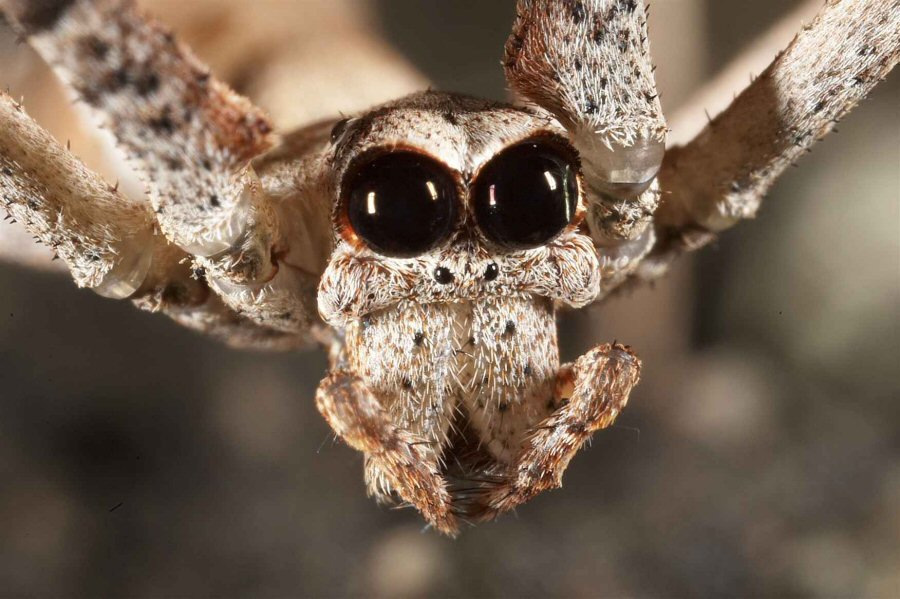
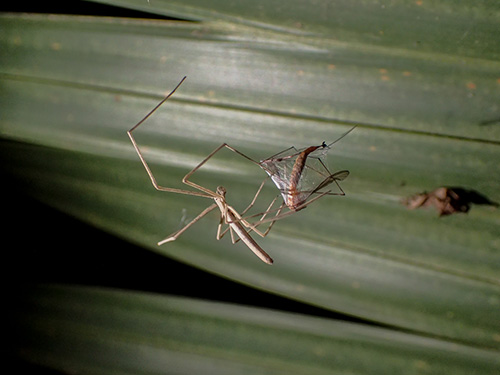
Introduction
Net-casting Spiders have a unique way of catching their prey. They make a small web in the form of a net held by the front legs that can be stretched out wide to envelop an unwary insect passing by.Deinopis spinosa, commonly known as an ogre-faced spider or gladiator spider, is in the net-casting spider family (Family: Deinopidae) found in the southeastern United States, the Caribbean, and South America (Bradley 2013, Stevenson et al. 2018). Deinopis spinosa is strictly nocturnal, mimicking a dead twig during the daylight hours (Getty and Coyle 1996). After sunset, Deinopis spinosa uses a unique ‘net-casting’ foraging strategy to capture prey (Coddington and Sobrevila 1987).
Identification
The spider has excellent eyesight, with a huge pair of forward facing eyes that help it to see at night. The genus commonly encountered in gardens is Deinopis. Another genus, Menneus, has less prominent eyes.
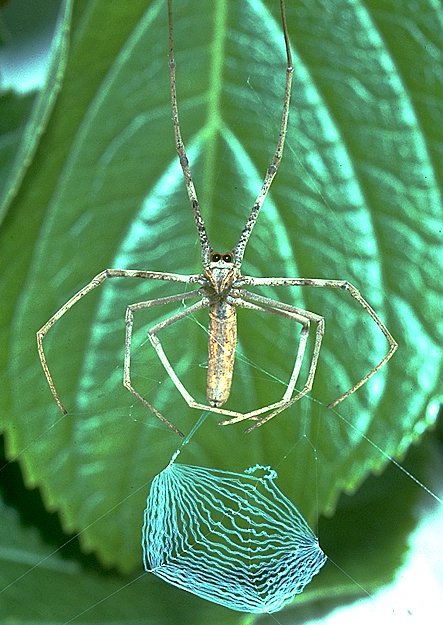
Net-casting Spiders have stick-like bodies, with spindly legs. Members of the genus Deinopis have a large, prominent pair of eyes at the front of the head (hence their other common name of Ogre-faced Spiders) and vary in colouring from fawn to pinkish brown or chocolate brown. Members of the genus Menneus have smaller eyes and have subtle greenish brown to grey patterning. The males are smaller and even more slender and stick-like than the females, and can differ from them in their colour and patterning.
The ogre-faced spider is a medium-sized spider (total body length of approximately 10-17mm) that gets its common name from its remarkably large forward-facing posterior median eyes (the two largest of its eight eyes) (Bradley 2013) (Fig. 1). These eyes are the largest eyes of any spider, with huge photoreceptors (the parts of the eye that capture light) that provide exceptional sensitivity to help them hunt at night (Land and Nilsson 2012). Relative to body size, the diameter of the posterior median eye is significantly smaller in mature males compared to immature males and females of all life stages (Stafstrom et al. 2017).
Deinopis spinosa has a long, slim body and legs that closely resemble the brown coloration and irregular, multicolored pattern of a dead twig (Getty and Coyle 1996) (Fig. 2). Mature males tend to be slightly less cryptic in posture and form than mature females (Stafstrom et al. 2017). Immature male Deinopis spiders closely resemble females, however the mature male can be distinguished by its large, bulbous pedipalps, extremely thin abdomen, and exceptionally long legs (Blest and Land 1977). During the day, when resting in their twig-like posture, they look superficially like other twig-like spiders (e.g., Miagrammopes spp. (family Uloboridae), Tetragnatha spp. (family Tetragnathidae). However, these other spider groups all have relatively small eyes, compared with the unmistakably large forward-facing eyes of Deinopis spinosa.
Habitat
They are often seen on fine summer nights among garden shrubs and trees.
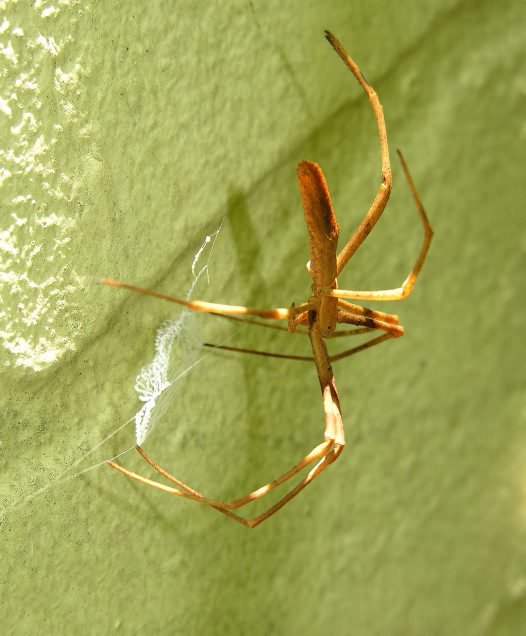
Deinopis spinosa is distributed across the coastal plain region of the southeastern United States (Stevenson et al. 2018) as well as the Caribbean and South America (Bradley 2013). Due to their cryptic nature, they are particularly difficult to find in the field, especially during the day (Getty and Coyle 1996). They are not known to be habitat specific and have been found in an array of terrestrial habitats including coastal hammocks, oak (Quercus) and pine (Pinus) forests, and close to swamps and marshes (Stevenson et al. 2018).
Distribution
Net-casting Spiders are widely distributed in forest habitats of south-eastern Australia.
Feeding and diet
They are primarily nocturnal, feeding on ants, beetles, crickets and other spiders.
Other behaviours and adaptations
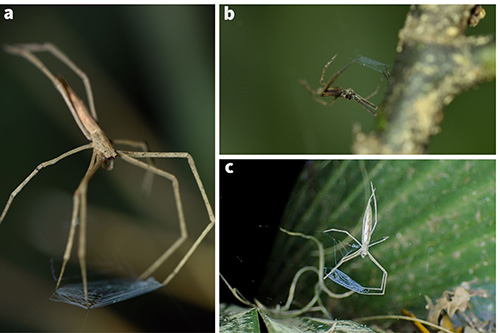
When at rest, the spider hangs from vegetation with its head downwards, its long body and long, thin front and back legs held together on each side, giving the spider a stick-like appearance. The spider also assumes a head-down position when it is waiting for prey, except that it now holds its net with the front four legs and suspends itself by the back legs and spinnerets from support lines to surrounding foliage. The net is a blueish-white square of wool-like cribellate silk, whose coiled lines are designed to stretch and entangle prey. In order to have an aiming point, the spider often drops splashes of white faecal droppings onto the leaf or bark substrate over which it is poised. When an insect walks across this ‘target’, the spider plunges its net downward to envelop and entangle it. If successful, the spider silk-wraps the prey item, bites and paralyses it, and then feeds on it. Net strikes will also be made at flying insects that stray too close. An unused net is sometimes stored by hanging it on nearby leaves for the next night’s hunting, or the spider may eat it.
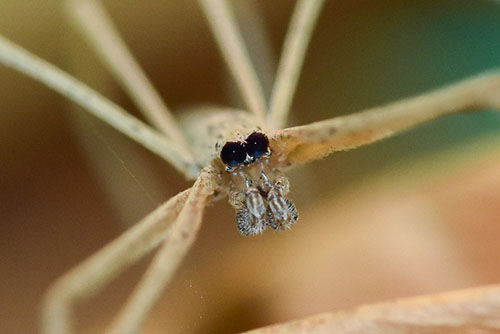
Life history cycle
After mating has taken place the female Net-casting Spider constructs strong spherical brown flecked egg sacs. Each sac is suspended among low foliage, either dead or living, by a short silk stalk and is further disguised using leaf debris.
Net-casting Spiders mature in summer, when mating and egg-laying occurs.
Danger to humans
These spiders are not considered to be dangerous.
Predators and Prey (Back to Top)
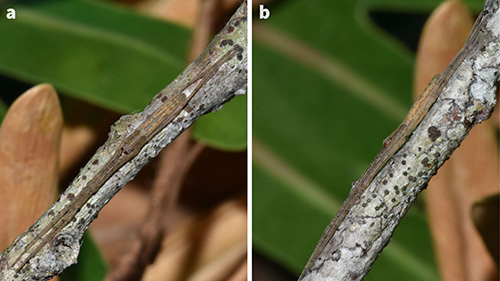
Deinopis spinosa assumes an anti-predator posture while at rest during the day. At dawn (usually around 5 a.m.) Deinopis spiders retract their capture web and settle into their cryptic, stick-like form. Most often, this position is assumed on or near and parallel to some type of concealment structure, which is usually a twig or vine. However, sometimes Deinopis spiders may be positioned well away from any substrate, relying more on their ability to mimic a twig than being concealed by one (Getty and Coyle 1996). Deinopis spiders are generalist predators and have been observed eating an array of walking and flying prey items, including crickets (Stafstrom et al. 2017), roaches, and beetles (Getty and Coyle 1996). There is little to no documentation on the predators of Deinopis spiders, but the potential for predation by birds or monkeys was noted in one study (Getty and Coyle 1996).
References
Gray, M. 1997. Australian Spiders. Australian Museum Information Disk. Edited & produced by Bill Rudman.
York Main, B. 1976. Spiders. William Collins Publishers Pty Ltd, Sydney NSW.
